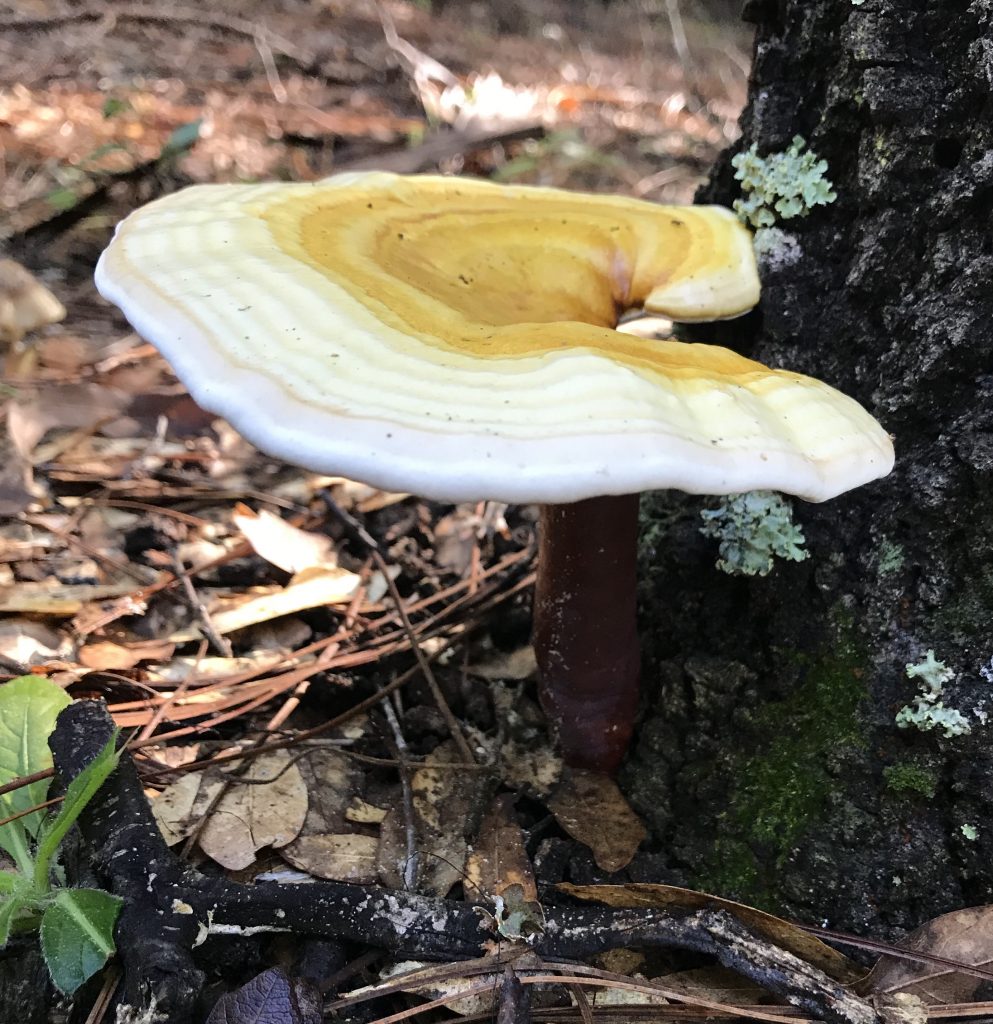
We have several species Reishi mushrooms in North America. This one is Ganoderma curtisii if growing on hardwood. Photo by Green Deane
The question isn’t whether Reishi mushrooms grow in North America. The question is what to call them. Some would argue there are only six species of Reishi mushrooms on this continent. Others say many more. Just as the botanical world is in DNA flux so to is the fungal realm. Regardless of the species the Reishis are all Ganodermas, a genus name that that always suffers from translation. One sees Ganoderma translated as “shiny skin.” That’s not exactly right. In Greek it actually means “polished leather.” When I think of shiny skin I think of what my fingers and toes looked like after getting chilblains or frost bite. My skin was shiny. It did not look like polished leather. By the way once you get chilblains you always have them. I can go into a well air-conditioned building in Florida and my fingers and toes will ache from frozen nights spent ice skating 60 years ago.
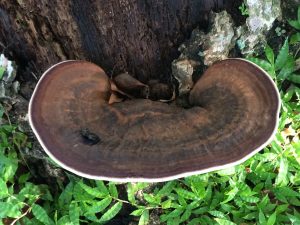
Ganoderma lobatum. Photo by Green Deane
Pictured on top is Ganoderma curtisii, an easy to identify Reishi mushroom. It’s almost always shaped like a P, or a golf club, some say a cobra. All the ones I have spied have been growing on oaks. In 1988 it was decided that a slightly different species grows on Pines especially in the Gulf Coast states. That is G. meredithiae name for fungal expert Meredith May Blackwell. As for use my herbalist friends tell me our Reishi mushrooms can be used like their more famous Asian relatives and do stimulate the immune system. Consult your local herbalist for detail
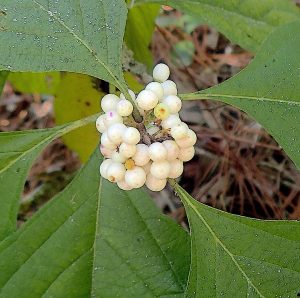
White Beautyberries. Photo by Green Deane
Are the berries to the left edible or not? Ninety-nine plus percent of white berries are not edible. White berries are a huge warning flag saying stay away. But there are exceptions. I can think of a few wild white berry species in the world that are edible, some in North America and one in Africa. But what of the berries pictured left? They are white American Beautyberries. Usually they are magenta when ripe. These are stark white. I have eaten a few. They taste like the colored ones. A few years ago I had a woman in New Jersey write to me and report she eats them all the time and makes jelly out of them. That’s not an official endorsement but it is about as close as one can get to knowing if they are edible. There are at least four species of Beautyberries that can spontaneously produce white berries, and there might be a man-made cultivar or two. The shrub at left had magenta colored berries for several years then went white for one year then back to colored berries. To read more about them click here.
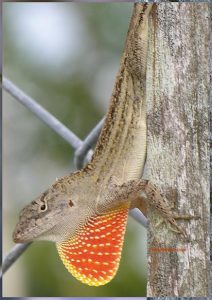
Cuban Anole
The smallest roundup ever happened once during one of my classes. At the end of all my classes we always relax and chat a bit. I happened to mention that the invasive, aggressive Cuban anoles taste like bacon (when deep fried.) That led to how to catch them and I told of one student who would make a noose out of panic grass and lasso them. One of the people at the class agreed that was how to do it and fashioned a noose for other students to use. Three of them went searching and one actually managed to catch an anole with a grass loop. Truth is stranger than fiction. To read about cooking them go here. You also might want to read: Ignite of the Iguana.
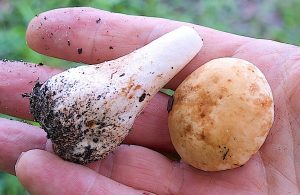
An edible Bolete with no name, Gyroporus subalbellus. Photo by Green Deane
One of my favorite mushroom had a name change, the Chestnut Bolete. It was Gyroporus castaneus the latter meaning chestnut. This worked well as the top of the bolete is often chestnut colored. The fungal powers that be decided the name Gyroporus castaneus can only be used for the European bolete. Those mushrooms called Gyroporus castaneus in the northern part of North America are now Gyroporus borealis. Those called Gyroporus castaneus in southern North America are now Gyroporus smithii. (Too bad Brownii wasn’t in the offering.) The genus name is from two Greek words that mean “round pores” as the mushroom does not have gills. There is no “eye” sound in Greek thus they never would say the other name for a hero sandwich gyro, g-eye-row. They would not call the mushroom “gye-ROPE-poor-us.” They say: “year-ROPE-poor-us,” or, “year-row-POOR-us.” Castaneus is “cass-TAN-ee-us.” Borealis is boor-ree-AL-us. Smithii is SMITH-ee-eye. The Boletes are a user-friendly group to study. There are no deadly ones per se if you’re in good health or ones that cause lasting organ damage should one err. Some can make you quite ill but you will live (unless your health is already compromised some way.)

Classes are held rain or shine or cold. (Hurricanes are an exception.) Photo by Kelly Fagan.
Foraging Classes:
Saturday September 21, Spruce Creek Park, 6250 Ridgewood Ave. Port Orange, 32127. 9 a.m. to noon. Meet at the pavilion.
Sunday September 22nd, Eagle Park Lake,1800 Keene Road, Largo, FL 33771. 9 a.m. to noon, Meet at the pavilion near the dog park,
Sept 28-29. The unknown track of a hurricane predicted for that time of the month, precludes scheduling any classes that weekend.
For more information on these classes, to prepay or sign up go here. The cost is $30 per adult (the class is usually three hours long and examines five-dozen or so species.) If cost is a hardship email me at: GreenDeane@gmail.com.
Crowfoot Grass, which is starting to ripen now, is not native to North America. It’s from Africa where the species is used to make unleavened bread and a frothy beer. While crowfoot grass is easy to harvest — when ripe — the grains are tiny, eye of a needle size. You can collect about two quarts an hour — making them calorie positive — and they can grow in large colonies making harvesting easy. Usually you collect the grains while sitting and using window screen plastic as a strainer. The grains have a small amount of cyanide in them but drying and cooking drives that off. Though minute botanically they are a mouthful: Dactyloctenium aegyptium. That means ‘little comb fingers from Egypt.’ You can find Crowfoot Grass from Maine to California skipping the upper northwest side of the country.

Green Deane Forum
Tired of Facebook and want to identify a plant? The Green Dean Forum is up and running again. Have you come to dislike Facebook, then join us on the forum. Perhaps you’re looking for a foraging reference? You might have a UFO, an Unidentified Flowering Object, you want identified. On the Green Deane Forum we — including Green Deane and others from around the world — chat about foraging all year. And it’s not just about warm-weather plants or just North American flora. Many nations share common weeds so there’s a lot to talk. There’s also more than weeds. The reference section has information for foraging around the world. There are also articles on food preservation, and forgotten skills from

You get the USB, not the key.
172-video USB would be a good end of spring present and is now $99. My nine-DVD set of 135 videos has been phased out. The USB videos are the same videos I have on You Tube. Some people like to have their own copy. Most of the 172 USB videos have to be copied to your computer to play. If you want to order the USB go to the DVD/USB order button on the top right of this page. That will take you to an order form.

Now in second printing.
EAT THE WEEDS, the book, 274 plants, 367 pages, index, nutrition charts and color photos. It’s available in many locations including Amazon. Most of the entries include a nutritional profile. It can also be ordered through AdventureKeen Publishing.
This is weekly newsletter #612. If you want to subscribe to this free newsletter you can find the sign-up form in the menu at the top of the page.
To donate to the Green Deane Newsletter click here.

Groundnuts Photo by Green Deane
Fruiting now and making it easy to spot are Ground Nuts, or Apios americana. This is a vine found in wet spots nearly everywhere east of the Rockies. It has clusters of maroon pea blossoms, which means “wings and keels.” The four petals of pea blossoms arrange themselves differently than most blossoms. Two flare out and two form together creating what looks like a boat’s keel and two wings. It has an edible pea pod thayt looks more like a string bean. Grounds Nuts are a foraging staple and were also the second plant product exported from the New World to the Old World. The first was Sassafras wood. While we find Ground Nuts in damp spots they will happily grow in a regular garden producing edible tubers for many years. More to the point, once you know what the underground tubers look like you can easily identify them anywhere you find them. To learn more about Ground Nuts go here.



On the SW coast of Portugal we eat the white berries of Corema album. The old people say that in the past they were sold at the entrance of cinemas.